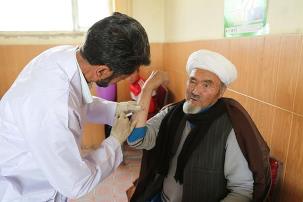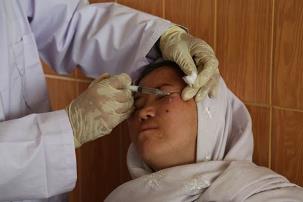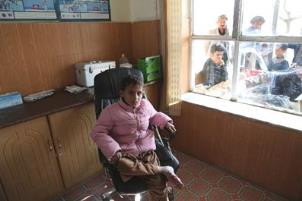 Nasir gets an injection to treat his leishmaniasis lesions at a WHO-supported treatment centre in Kabul. Photo: WHO/S.RamoKabul 22 January 2017 - Around 20 million Afghans in 21 provinces are at risk of cutaneous leishmaniasis, a tropical disease transmitted by the bite of a sandfly. The disease may also lead to open lesions and disfigurement, usually on the exposed areas of the body, mainly on the face and hands, and is associated with severe social stigma, especially for women and girls.
Nasir gets an injection to treat his leishmaniasis lesions at a WHO-supported treatment centre in Kabul. Photo: WHO/S.RamoKabul 22 January 2017 - Around 20 million Afghans in 21 provinces are at risk of cutaneous leishmaniasis, a tropical disease transmitted by the bite of a sandfly. The disease may also lead to open lesions and disfigurement, usually on the exposed areas of the body, mainly on the face and hands, and is associated with severe social stigma, especially for women and girls.
In 2015, more than 25 000 new cases of cutaneous leishmaniasis were reported in Afghanistan, although the actual number is likely to be much higher. Kabul suffers from the highest cutaneous leishmaniasis burden in the world, with around 10 000 new cases reported every year.
“Leishmaniasis is a neglected disease. We don’t have enough treatment centres in Afghanistan, leishmaniasis drugs are often not available at the primary healthcare level and health staff lack the capacity to diagnose and treat patients. People rely a lot on our centre here but we cannot help everyone,” said Dr Sami Nazhat, director of the National Malaria and Leishmaniasis Control Programme in Kabul.
Cutaneous leishmaniasis is the most common form of the disease, while around 15 cases of visceral leishmaniasis, a more serious and sometimes fatal form of the disease, are also being reported every year in Afghanistan.
Stigma affects the most vulnerable
Leishmaniasis generally affects the poor and is associated with malnutrition, population displacement, poor housing and a weak immune system. Sandflies that spread the disease are often found in crowded areas with poor sanitation.
Although cutaneous leishmaniasis is not lethal, it creates multiple harmful social consequences, affecting the lives of tens of thousands of Afghans. Particularly women and girls suffer from stigma due to scarring caused by the disease.
 15-year-old Gulsum receives an injection to treat leishmaniasis. Photo: WHO/S.Ramo“It is a very serious issue. I know of cases where families wouldn’t let a woman touch the dishes at home or the husband refused to share a bed with his wife. I also heard of an engagement being broken off because the woman had leishmaniasis. This disease destroys women’s lives,” said Dr. Ahmadi.
15-year-old Gulsum receives an injection to treat leishmaniasis. Photo: WHO/S.Ramo“It is a very serious issue. I know of cases where families wouldn’t let a woman touch the dishes at home or the husband refused to share a bed with his wife. I also heard of an engagement being broken off because the woman had leishmaniasis. This disease destroys women’s lives,” said Dr. Ahmadi.
Leishmaniasis is treatable and curable. The use of insecticide-sprayed bed nets as well as good sanitation and proper waste disposal facilities lower the risk of contracting the disease in endemic areas.
“I have had this disease and these lesions on my face for 11 months. First, I went to a private clinic but they weren’t able to help me. My neighbour told me about this place so I came here,” said Farzana, a young woman in her 20s, covering a large purple mark and open lesion on her face with her scarf. “People are really mean to me and say bad things although they know that they can’t catch this disease from me.”
Cutaneous leishmaniasis can easily be treated by a series of injections of sodium stibogluconate to the lesions. However, many people cannot access treatment and only a few health centres are capable of administering these injections. Many cannot afford the long travel that is required to reach the centre.
“This is the third time I am visiting this centre to get my injections. This place is very far from my home and it is not easy for me to come here. Many people in my neighbourhood have this same disease so we often come here together to get our medicines,” said Manizha.
In the absence of treatment, some people rely on traditional healers who often make the scars and lesions worse by administering harmful chemicals on them. This happened to 10-year-old Noori who was carried by his brother to the treatment centre with painful open lesions on his foot. He stopped going to school a month ago because the burning lesions make it impossible for him to walk.
Neglected disease, limited resources
After long-standing advocacy by WHO and partners, leishmaniasis treatment has been finally added to the Afghanistan’s Basic Package of Health Services (BPHS) in 2016. However, full integration that ensures the availability of drugs and treatment capacity in all health facilities is a lengthy process.
“Leishmaniaisis affects the poorest and marginalized. WHO supports the diagnosis and treatment of affected communities and we continue to provide leishmaniasis drugs to treatment centres,” said Dr. Supriya Warusavithana, programme manager at WHO Afghanistan. “We continue our joint efforts to ensure that leishmaniasis treatment is well integrated into Afghanistan’s basic health system to ensure free, quality-assured treatment to all those in need around the country.”
 Noori suffers from a painful open sore in his foot but is about to receive treatment at this leishmaniasis treatment centre in Kabul. Photo: WHO/S.RamoWhile the open lesions and sores caused by leishmaniasis can be treated, the social stigma and shame associated with scars is long-lasting.
Noori suffers from a painful open sore in his foot but is about to receive treatment at this leishmaniasis treatment centre in Kabul. Photo: WHO/S.RamoWhile the open lesions and sores caused by leishmaniasis can be treated, the social stigma and shame associated with scars is long-lasting.
“We need to fight the stigma associated with the disease by raising people’s awareness, improving early treatment seeking behaviour and changing harmful attitudes, especially against women and girls,” said Dr. Warusavithana.
Due to increasing population density, movements, displacement, crowded and poor living conditions in urban areas, more people are at risk of contracting leishmaniasis. Over 600 000 Afghans returned from Pakistan and Iran in 2016 and more than 623 000 Afghans fled their homes due to conflict, creating more overcrowding in urban areas and pressure on overstretched health services.
More resources are desperately needed to effectively combat leishmaniasis to prevent thousands of Afghans contracting this debilitating disease. WHO continues to support the Ministry of Public Health’s National Malaria and Leishmaniasis Control Programme through building the capacity of health workers for effective diagnosis and treatment, strengthening disease surveillance and procuring medicines to health centres around the country.
WHO Afghanistan leishmaniasis programme


